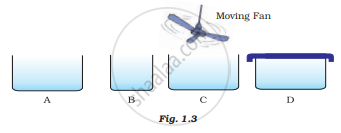Advertisements
Advertisements
प्रश्न
The scientists now say that there are actually five states of matter A, B, C, D and E. The state A has a fixed volume but no fixed shape. The state B can be compressed very easily by applying pressure and state C has a fixed shape as well as a fixed volume. The state D is a mixture of free electrons and ions whereas state E is named after an Indian scientist and a famous physicist.
- Name the physical states (i) A (ii) B (iii) C (iv) D, and (v) E
- Name one substance belonging to state C which can directly change into vapours on heating. What is this process known as ?
- Name one substance which normally belongs to state B but whose solid form changes directly into gaseous state.
- Name the most common substance belonging to state A.
- Which state of matter makes the sun and other stars to glow ?
उत्तर
- The physical states are
- A-liquid
- B-gas
- C-solid
- D-plasma and
- E-Bose-Einstein condensate (BEC).
- Ammonium chloride; and the name of the process is sublimation.
- Carbon dioxide
- Water
- Plasma is the state of matter that allows the sun and the other stars to glow.
APPEARS IN
संबंधित प्रश्न
How does water kept in an earthen pot (matka) become cool during summer?
Why does our palm feel cold when we put some acetone or petrol or perfume on it?
What produces more severe burns, boiling water or steam?
Evaporation takes place from the
A patient suffering from high fever is advised to put wet clot strips on his forehead. Why?
Why is heat energy needed to melt a solid ? What is this heat energy called ?
Why does all the water of the earth not get evaporated during hot summer days ?
Why are we able to sip hot tea or milk faster from a saucer rather than from a cup ?
Give a geographical reason:
Air becomes saturated.
Look at Fig. 1.3 and suggest in which of the vessels A,B, C or D the rate of evaporation will be the highest? Explain.

